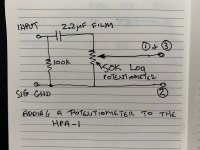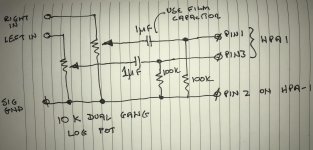Each transistor dissipates about 1.3 Watts, so total 5.2 W for both channnels. I’d say your enclosure would work just fine for the HPA-1
🙂
🙂
I admire your enthusiasm, however I think you should pay slightly more attention to DFM (design for manufacturability). It seems the mounting holes are touching the board outline, some caps are touching the AC/DC converter, the output relay is almost touching the headphone connector and some traces/pads are very close to each other while there is plenty of space in the area.
Take a close look at the design rules of the PCB manufacturer you are planning to use and if possible don't even try to utilise all their capabilities in terms of minimum spacing, via size etc. . Try to avoid going to ever finer snap grids. The problem with CAD is that you can always zoom in as far as you want and easily lose sense of proportion.
Take a close look at the design rules of the PCB manufacturer you are planning to use and if possible don't even try to utilise all their capabilities in terms of minimum spacing, via size etc. . Try to avoid going to ever finer snap grids. The problem with CAD is that you can always zoom in as far as you want and easily lose sense of proportion.
The mounting holes have to be in that position because the case I'm using has them in that position. Everything has a courtyard in kicad so I'm making sure none of them overlap so when the board is made, none of the components will actually touch. I'm using JLCPCB so I know I can get away with packing stuff in like this.
Some of it you might be able to get away with, but you absolutely cannot have copper within 0.5mm of the board outline for most PCB manufacturers. You will have to use NPTHs (Non-Plated Through Holes) for the mounting holes or the design will probably be declined.
Do you guys think this would also work when replacing the thin film resistors with metal film resistors (1% tolerance)?
No reason why it shouldn't, just make sure they're similar power ratings or sim the circuit and see which resistors need higher power
Hey 🙂
Is it possible to add a volume control? Can I use the HP-out and add a log. potentiometer?
Is it possible to add a volume control? Can I use the HP-out and add a log. potentiometer?
V1.1 of my board 🙂
Took into account the criticism regarding spacing everything out a bit more sensibly - I got too excited about packing everything into a small space 😀 also added an RF filter and then Bonsai's changes before the pot, there was plenty of board space for that.

Took into account the criticism regarding spacing everything out a bit more sensibly - I got too excited about packing everything into a small space 😀 also added an RF filter and then Bonsai's changes before the pot, there was plenty of board space for that.

Andrew, if we opted for a jfet based opamp, am I mistaken if I say the DC blocking cap isn't needed?
Here is a better way to connect a lot. This blocks the input opamp bias current from flowing through the pot, which will become noisy after a while. JFET opamps generally don’t have this issue on low value pots of say up to 10 or 20 k Ohms. But with an NE5532A, (which the HPA-1 has been tested with) it will, and even using an LM4562 might cause pot scratching noise.
With the approach shown below you can use a good quality film coupling cap of 1 uF.
Note that the 100 k resistors will load the potentiometer, so you should use a value of 10 k for the pot or lower. Most preamplifiers will have no problem driving a load of greater than 2 k so you should be good to go.
With the approach shown below you can use a good quality film coupling cap of 1 uF.
Note that the 100 k resistors will load the potentiometer, so you should use a value of 10 k for the pot or lower. Most preamplifiers will have no problem driving a load of greater than 2 k so you should be good to go.
Attachments
Thank you Bonsai 🙂 Just a thought: It's probably not a good idea to connect a second pair of headphones in parallel? Then the resistance would be divided in half (2x 32 Ohm -> 16 Ohm resistance). Would you recommend to build 2 more HPA-1 (left channel and right channel) for this and connect them to the same input source?
- Home
- Amplifiers
- Headphone Systems
- X-Altra HPA-1 Class A Headphone Amplifier


